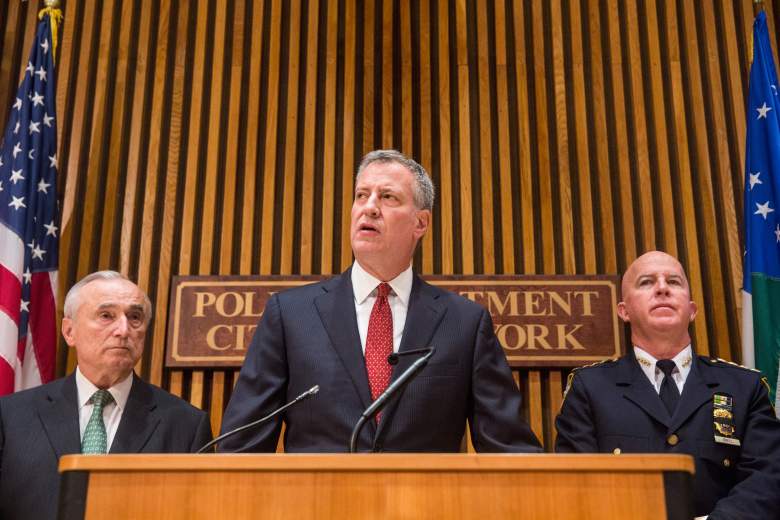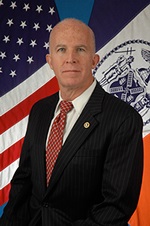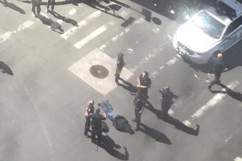
New York Police Commissioner William Bratton, Mayor Bill De Blasio and Chief of Department James P. O’Neill. (Getty)
New York Police Chief of Department James P. O’Neill, a 30-year veteran of the force, will be the new New York City Police Commissioner after William Bratton officially steps down in September. As Chief of Department, O’Neill was the highest-ranking uniformed police officer in the largest police force in the country. He held the position between October 2014 and September 2016.
Bratton said in July that he would resign by the end of 2017, The New York Times reported. However, on Tuesday, The Times reported that Bratton will resign in September. O’Neill was named his successor and assumed office on September 16, 2016, just a day before the bombing on W 23rd Street in Chelsea.
Here’s a look at O’Neill’s career.
1. O’Neill Has Been an Officer Since 1983, When He Joined the Transit Police

Bratton, De Blasio and O’Neill in October 2015. (Getty)
O’Neill, 60, entered the New York Police Department as an officer in 1983 with the New York City Transit Police Department, according to his NYPD bio. He quickly rose the tanks, becoming Sergeant in 1987 and Sergeant Special Assignment in 1991.
In June 2014, he was named Chief of Patrol. Just a few months later in October 2014, he was named Chief of Department. He is the 38th person to hold the position, which was created in 1973 and previously known as Chief Inspector and Chief of Operations.
O’Neill is a graduate of John Jay College, where he earned a Bachelor of Arts in Government and Masters in Public Administration.
2. O’Neill Hopes to Change the Perception of Police by Having Officers Build Relationships With Residents

O’Neill in December 2015. (Getty)
Even before the police shooting in Dallas and the shootings of black men in Minnesota and Louisiana, O’Neill was trying to change the way the public sees police officers with “neighborhood policing.” The Wall Street Journal reported in a July 2016 profile of O’Neill that he told precinct leaders that they need to get out of their cars to talk with residents.
Three weeks after O’Neill got his promotion to Chief of Department, there were protests after the police officers in the Michael Brown and Eric Garner cases weren’t charged and two police officers were killed in Brooklyn.
“Right from the onset, the weight was tremendous,” O’Neill told the Wall Street Journal.
“He has a full understanding that to be successful at crime reduction you need cooperation with the public,” Bratton told the Wall Street Journal of O’Neill.
3. O’Neill’s Career Was in Danger After the Narcotics Division Was Giving Informants Drugs Instead of Money

The NYPD December 2015 graduating class. (Getty)
O’Neill’s career was in danger in 2008, when he was the commander of the NYPD narcotics division. That year, officials discovered that officers were paying informants with rugs instead of cash, The New York Times reported at the time. O’Neill and two others were transferred out of the narcotics department.
The scandal involved the arrest of four Brooklyn officers and prosecutors called for over 80 criminal cases to be dismissed. Three other officers were suspended and lost their badges and guns. O’Neill was replaced by Deputy Chief Joseph Reznick, the Daily News reported.
O’Neill, who has two sons, could have seen his career end. But he stayed on the force. When Bratton became NYPD commissioner for a second time in his career, he picked O’Neill as a member of his executive staff.
4. O’Neill Says He Loves His Job Because ‘It’s Apolitical’
When Bratton announced plans to resign, O’Neill instantly became his rumored successor. When asked about the job he has now, O’Neill says he loves his job because it’s “apolitical.”
“The beauty of my job is it’s apolitical,” O’Neill told the media, The New York Daily News reported. “I love what I do. I love being a cop. I love this uniform, so however I can serve this city. I enjoy this and I enjoy seeing what the greatest men and women of the NYPD do every day.”
Bratton also told The New York Times that he sees a bit of himself in O’Neill.
“I was the Jimmy O’Neil, if you will, of the Boston police,” Bratton said. “So, it’s very gratifying; a lot of what Jimmy is implementing now, here, is in many respects what I implemented back then. And it worked back then.”
5. O’Neill Said ‘We Have to Draw a Line’ After Officers Were Injured in Protests

(NYPD)
In December 2014, two police lieutenants were hospitalized after being injured during protests of the Garner and Brown cases ending without indictments. The two officers were trying to make an arrest during a Brooklyn Bridge march, Politico reports.
“This is where we have to draw the line,” O’Neill told the media.
Just days after the protests, two police officers were targeted and killed in Brooklyn. The reaction to the murders was police on patrol ordered to do so in pairs and a suspension of unarmed auxiliary officers patrolling. O’Neill even told commanders to make sure that their social media comments were only condolences for the killed officers.
These moves may have undermined the “neighborhood policing” idea, but O’Neill is still dedicated to it. “Eventually, we’d like to have every precinct in the city go with the (neighborhood coordination officers) model,” O’Neill said in May, The Daily News reports. “We just have to identify additional police officers. This is a personnel intensive model.”



